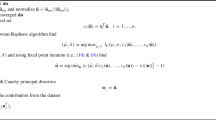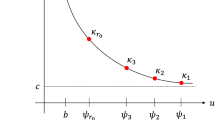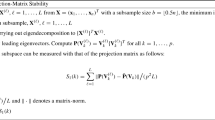Abstract
In this paper, we propose a criterion based on the variance variation of the sample eigenvalues to correctly estimate the number of significant components in high-dimensional principal component analysis (PCA), and it corresponds to the number of significant eigenvalues of the covariance matrix for p-dimensional variables. Using the random matrix theory, we derive that the consistent properties of the proposed criterion for the situations that the significant eigenvalues tend to infinity, as well as that the bounded significant population eigenvalues. Numerical simulation shows that the probability of estimator is correct by our variance variation criterion converges to 1 is faster than that by criterion of Passemier and Yao [Estimation of the number of spikes, possibly equal, in the high-dimensional case. J. Multivariate Anal., (2014)](PYC), AIC and BIC under the finite fourth moment condition as the dominant population eigenvalues tend to infinity. Moreover, in the case of the maximum eigenvalue bounded, once the gap condition is satisfied, the rate of convergence to 1 is faster than that of PYC and AIC, especially the effect is better than AIC when the sample size is small. It is worth noting that the variance variation criterion significantly improves the accuracy of model selection compared with PYC and AIC when the random variable is a heavy-tailed distribution or finite fourth moment not exists.
Similar content being viewed by others
References
Akaike, H. Information theory and an extension of the maximum likelihood principle. In: 2nd Information Symposium on Information Theory. Springer, Berlin, 1973
Anderson, T.W. Asymptotic theory for principal components. Annals of Mathematical Statistics, 34: 122–148 (1963)
Bai, Z.D., Choi, K.P., Fujikoshi, Y. Consistency of aic and bic in estimating the number of significant components in high-dimensional principal component analysis. Annals of Statistics, 46: 1050–1076 (2018)
Bai, Z.D., Silverstein, J.W. Spectral analysis of large dimensional random matrices (Second Edition). Springer, Berlin, 2010
Bai, Z.D., Yao, J.F. Central limit theorems for eigenvalues in a spiked population model. Annales de l’Institut Henri Poincaré- Probabilités et Statistiques, 44: 447–474 (2008)
Bai, Z.D., Yao, J.F. On sample eigenvalues in a generalized spiked population model. Journal of Multivariate Analysis, 106: 167–177 (2012)
Bai, Z.D., Silverstein, J.W. CLT for linear spectral statistics of large-dimensional sample covariance matrices. Annals of Probability, 32: 553–605 (2004)
Baik, J., Silverstein, J.W. Eigenvalues of large sample covariance matrices of spiked population models. Journal of Multivariate Analysis, 97: 1382–1408 (2006)
Chakraborty, A., Mukherjee, S.S., Chakrabarti, A. High dimensional PCA: a new model selection criterion. arXiv:2011.04470v1, 2020
Ferre, L. Selection of components in principal component analysis: A comparison of methods. Computational Statistics & Data Analysis, 19: 669–682 (1995)
Fujikoshi, Y., Sakurai, T. Some properties of estimation criteia for dimensionality in principal component analysis. American Jounal of Mathmatical and Management Sciences, 35: 133–142 (2016)
Fujikoshi, Y., Sakurai, T., Yanagihara, H. Consistency of high-dimensional aic-type and cp-type criteria in multivariate linear regression. Journal of Multivariate Analysis, 123: 184–200 (2014)
Hotelling, H. Analysis of a complex of statistical variables into principal components. Journal of Educational Psychology, 24: 417–441 (1933)
Johnstone, I.M. On the distribution of the largest eigenvalues in principal components analysis. Annals of Statistics, 29: 295–327 (2001)
Jolliffe, I.T. Principal component analysis (2nd ed.). Springer, Berlin, 2002
Kim, Y., Kwon, S., Choi, H. Consistent model selection criteria on high dimensions. Journal of Machine Learning Research, 13: 1037–1057 (2012)
Luo, W., Li, Bing. Combining eigenvalues and variation of eigenvectors for order determination. Biometrika, 103: 875–887 (2016)
Luo, W., Li, Bing. On order determination by predictors augmentation. Biometrika, 108: 557–574 (2021)
Paul, D. Asymptotics of sample eigenstruture for a large dimensional spiked covariance model. Statistica Sinica, 17: 1617–1642 (2007)
Passemier, D., Yao, J.F. On determining the number of spikes in a high-dimensional spiked population model. Random Matrices: Theory and Applications, 1: 1150002 (2012)
Passemier, D., Yao, J.F. Estimation of the number of spikes, possibly equal, in the high-dimensional case. Journal of Multivariate Analysis, 127: 173–183 (2014)
Pearson, K. On lines and planes of closest fit to systems of points in space. Philosophical Magazine, 11: 559–572 (1901)
Schwarz, G. Estimating the dimension of a model. Annals of Statistics, 6: 461–464 (1978)
Shao, J. An asymptotic theory for linear model selection. Statistica Sinica, 7: 221–264 (1997)
Shibata, R. Selection of the order of an autoregressive model by akaike information criterion. Biometrika, 63: 117–126 (1976)
Wang, Q., Yao, J. On the sphericity test with large-dimensional observations. Electronic Journal of Statistics, 7: 2164–2192 (2013)
Yanagihara, H., Wakaki, H., Fujikoshi, Y. A consistency property of the aic for multivariate linear models when the dimension and the sample size are large. Electronic Journal of Statistics, 43: 231–245 (2015)
Yang, Y. Can the strengths of aic and bic be shared? a conflict between model indentification and regression. Biometrika, 92: 937–950 (2005)
Acknowledgments
The authors sincerely thank the editor, the associate editor and the two referees for their constructive comments and suggestions that have substantially improved the original manuscript.
Author information
Authors and Affiliations
Corresponding author
Additional information
This work is partly supported by National Natural Science Foundation of China (Nos: 12031016, 11971324, 11471223); Foundations of Science and Technology Innovation Service Capacity Building, Interdisciplinary Construction of Bioinformatics and Statistics, and Academy for Multidisciplinary Studies, Capital Normal University, Beijing.
Rights and permissions
About this article
Cite this article
Wang, Gp., Cui, Hj. Variance Variation Criterion and Consistency in Estimating the Number of Significant Signals of High-dimensional PCA. Acta Math. Appl. Sin. Engl. Ser. 38, 513–531 (2022). https://doi.org/10.1007/s10255-022-1094-4
Received:
Accepted:
Published:
Issue Date:
DOI: https://doi.org/10.1007/s10255-022-1094-4




